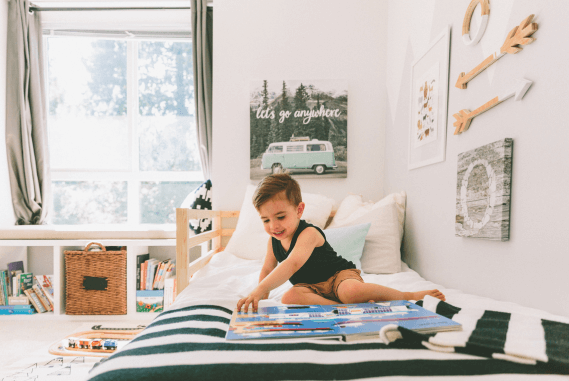Ready for a toddler bed? 4 things you need to know before transitioning from crib to bed
When your child is ready to be done with the crib, it can be such an exciting time! It can also feel a little scary because you have no idea how your child will respond to this big change. As a mom I’ve been through this transition before. I’ve also had the privilege to help other families as they move their toddler from crib to bed. From this experience, I’d say there are 4 big things you need to know before you even begin transitioning. I don’t want you to rush into things feeling unprepared so I’ve put together this blog post to help guide you!
#1 When to transition from crib to bed
One of the most important things you need to know is when to make the leap. As a first time mom, I made the mistake of transitioning my oldest too early. She was only 22 months and had shown no signs of climbing out of her crib but I still moved her because I wanted to free up the crib for the new baby. In retrospect, she just was not ready and moving her so young actually made her sleep worse. If I could tell past me to wait longer, I would! If you make the transition too early, you may notice an increase in bedtime battles, night wakings cropping up, and really early morning wake up calls.
If you can, try to wait until your child is at least 3 years of age. Children under 3 are just not developmentally ready to move out of the crib. They don’t have the skills to understand boundaries associated with not having the walls of their crib. Apart from age, you may also decide to make the transition when your child is getting too tall for the crib or when they are climbing out and it’s becoming unsafe.
It’s important to remember that there is no rush to get your child out of their crib- yes, even if you are expecting a new baby. It’s better to wait for an ideal time than to feel rushed into this transition. If you do have a new baby on the way, remember that you may be room sharing for several months and therefore not need the crib right away. Bassinets and playpens work just as well for babies and go through the same rigorous safety testing that cribs do. If buying a second crib isn’t in the budget, then I’d recommend using a playpen for the new baby until your older child is fully ready to transition out of the crib.
#2 What to transition into after the crib
Once you decide you’re ready to transition from crib to bed, the next question is what kind of bed should you transition your child into? You have several options, whether it be the convertible crib, a toddler bed, or even a twin/full size bed. Here is a quick breakdown:
Convertible crib: When possible, this is my first choice because it equals less change for your child. While the crib will be converted into a toddler bed, it still looks and feels a lot like the crib that they are used to so I find the transition can sometimes be smoother when you take this route. This isn’t always possible, for instance, if you are trying to free up the crib for a new baby or maybe your child has completely outgrown the crib for sleeping. But if this is an option for your situation, I recommend it.
Toddler bed: If you can’t use a convertible crib, then a toddler bed could be a good next choice. Toddler beds tend to be inexpensive and are just the right size- not too big and not too small. The downside to using a toddler bed is simply that you will have to upgrade to something bigger within a few years so it might feel like you don’t get as much use out of it as you’d like.
Twin or full size bed: If you transition straight to a bigger bed, then you know you won’t have to upgrade in the future. This can be nice to just think about making 1 single transition now and then being done for many many years. If you go with this option, the main thing you want to be sure of is that your child can easily get in and out of bed completely on their own. If the bed frame is too high and it’s difficult for your child to climb in and out of bed without you, that could cause sleep issues down the road.
#3 How to prep for the transition from crib to bed
When you’re finally ready to make the transition, I recommend having a short countdown of 3-5 days. Create a little countdown where each morning you cross off a day and use this as an opportunity to talk about the transition together. Build excitement about the transition but also be sure to touch on your usual sleep routines and sleep expectations. Help your child to look forward to this change while also realizing that sleep itself is not changing. Here are some example conversation starters below:
“I’m so excited for you to sleep in your new bed in 3 days! We’ll do our bedtime routine like always but then we’ll tuck you into bed instead of putting you in the crib.”
“What’s happening in 2 days? Yes, you get to sleep all night in your new bed!”
“It’s okay if it feels different trying to fall asleep in your new bed. What do you do in your crib right now when you have trouble falling asleep?”
“Tonight is the night we are switching you to your new bed! At dinnertime we’ll go over our sleep rules again so they are fresh in our brains.”
If you’d also like to build excitement for the transition by letting your child pick out new bedding or rearranging the room, go for it! Have them “help” as you take down the crib and set up the new bed. Try to involve your child in as much of the process as possible so that they feel like a member of the team.
#4 What to expect during the transition
It is completely normal for the transition from crib to bed to be temporarily disruptive to your child’s sleep. This is a big change after all. But, if we aren’t prepared for them, those sleep disruptions tend to stick around, and eventually turn into new sleep habits. So something very important for you to do as you navigate the transition is to have a mental plan of action in mind. By that I mean, how will you respond if your child starts to get out of bed repeatedly? What will you do if your child starts requesting you stay in the room longer and longer? How will you handle a 5am wake up where your child leaves their room and starts acting like it's wake up time?
These are all important “what ifs” to not only think through but be sure you and your partner are communicating about before they happen. One of the sticking points for young children and sleep is boundaries and you need to be prepared to be their calm and confident leader during this transition. This blog post about bedtime stalling can be a really helpful read if you find yourself struggling with boundaries.
You also may experience a “honeymoon phase” where the first few weeks or months after the transition are problem free. This is often because your child has simply not yet realized their newfound freedom so they don’t feel the need to test it out. But if this phase is followed by some intense testing, you’ll need to be prepared to hold those sleep boundaries clearly and consistently for your child.
If your child struggles with staying in their room at sleep time, I find it’s best to shift our focus. Instead of worrying about making your child stay in bed or feeling like you have to rush in each time you see them get out of bed on the monitor, focus on whether they are in their room or not. If your child is just exploring their dark room, let that go. Don’t worry about it until they start to actually leave their room. If they do start to leave their room, you have a couple options for responding:
The Silent Return- With this strategy, you will quickly, quietly, and calmly walk your child back to bed each time they leave their room. This should be something that feels boring and unengaging so that we don’t accidentally incentivize your child to continue leaving their room. You may have to do a lot of silent returns at first, but as long as you can stay cool and collected throughout, it should make a big difference.
Expand the Crib- Another alternative is to change your perspective of your child’s room. Previously, your child was contained by their crib and is therefore used to that containment. Now that they are out of the crib, treat their whole room like it is a crib and use a visual boundary at the doorway that you feel comfortable with. This could simply be a shut door or even a baby gate. With this strategy, you eliminate the issue of your child repeatedly leaving the room so that you can respond however you prefer without them coming to find you first.
It’s important to remember that boundary-testing is a normal part of your child’s development. By remaining firm yet compassionate in enforcing boundaries and helping them adjust to this transition, you can support their growth and keep healthy sleep habits in place.
If you find it challenging to get into a good sleep groove after making the transition from crib to bed or you encounter issues as you make the transition, don’t hesitate to reach out for support. You might consider scheduling a complimentary consultation to explore personalized solutions that address your family’s specific needs.

